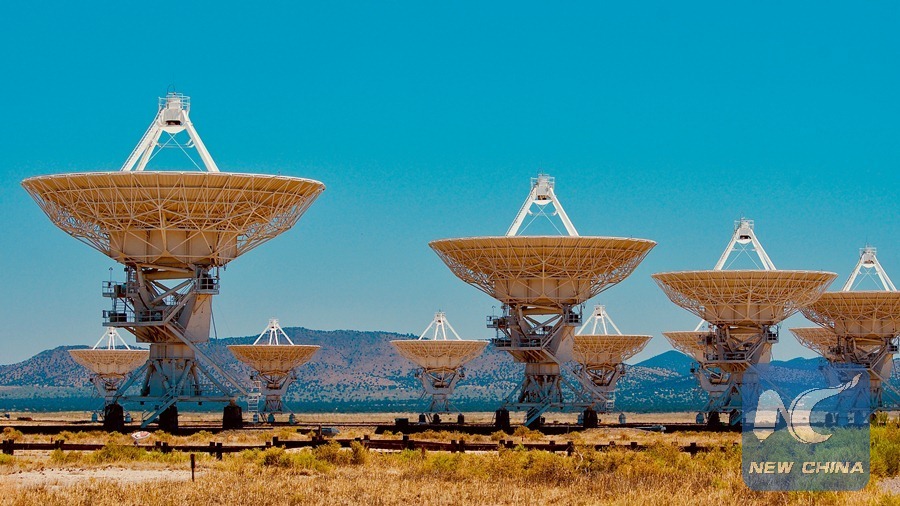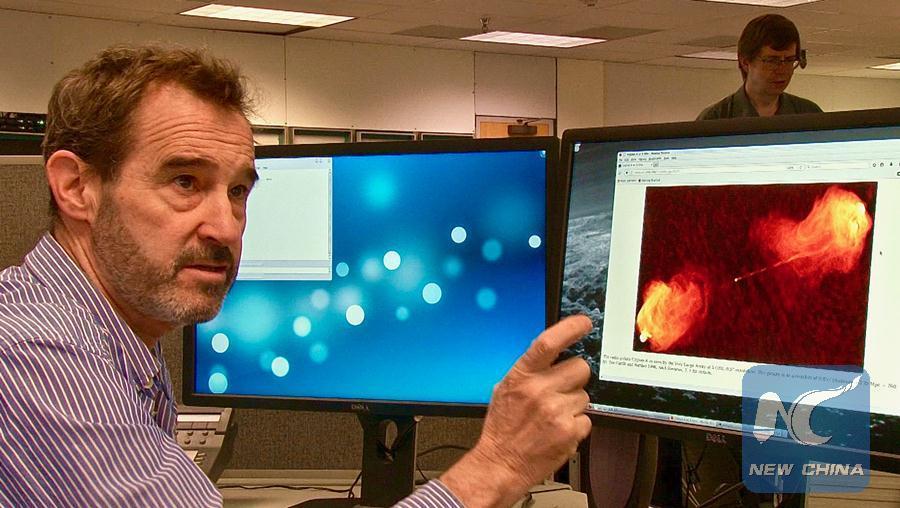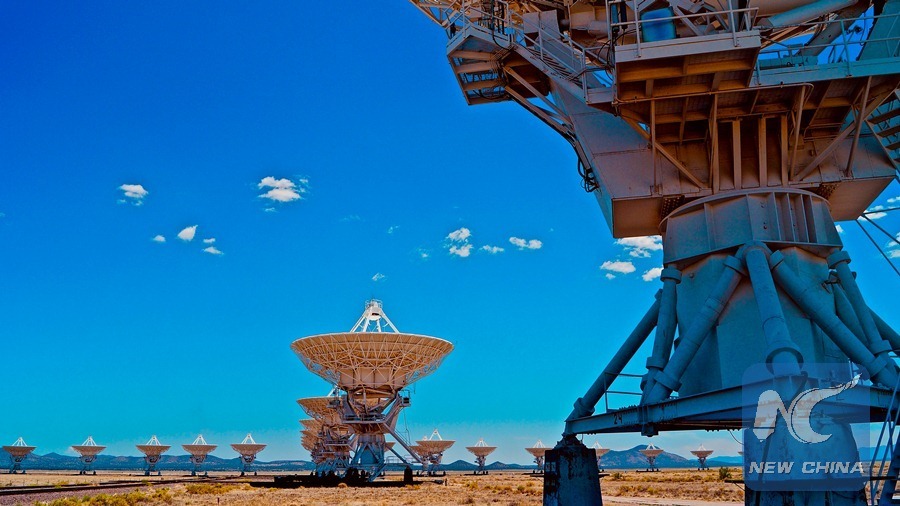
The Karl G. Jansky Very Large Array is seen on a high desert plateau, surrounded by mountains, in New Mexico, the United States, on Sept. 3. (Xinhua/ Richard Lakin)
by Richard Lakin
ALBUQUERQUE, the United States, Sept. 8 (Xinhua) -- Laying on a remote desert area in southern United States, a radio astronomers observatory attracts researchers and tourists all over the world. Being one of the busiest telescope on earth, it serves as a facility where many important discoveries were made.
The Karl G. Jansky Very Large Array (the VLA) is a radio astronomy observatory located on an isolated high desert plateau in western New Mexico state of the United States. Situated on a dry lakebed on the plains of San Agustin at 2,124 meters elevation, it is encircled by mountains, making it an ideal spot to avoid the normal wireless interference from cities. It is extremely dry there, and the lack of humidity in the air also makes for a clearer radio signal.
The VLA was named to honor Karl Guthe Jansky, who is considered to be the U.S. father of radio astronomy. Jansky was a physicist and radio engineer employed by Bell Laboratories to determine the source of interference to their overseas wireless communications. In 1933 he surprised the world's astronomers by announcing that one of the sources was extraterrestrial -- radio waves emitting from the gaseous center of the Milky Way galaxy. In the decades since, astronomers and engineers have advanced the science of translating these radio waves into observable images.

Dr. Chris Carilli, the Chief Scientist for the National Radio Astronomy Observatory explains a telescope image of explosive jets formed by matter being pulled into a black hole, in New Mexico, the United States, on Sept. 3. (Xinhua/Richard Lakin)
When the VLA first comes into view on the drive across the desert, the massive size of the array is very awe-inspiring. There are 27 radio dishes, each one 25 meters across and weighing 209 tons. The data from each dish is combined via a supercomputer, creating a singular radio telescope observation.
The dishes are arranged in a Y-shaped pattern, and are moved into different configurations on a network of railroad tracks to facilitate specific observation projects. Each of the 3 legs of the configuration contains 9 dishes and can be moved from two-thirds of a mile to 23 miles in length. The configuration changes about every 3 to 4 months to accommodate the research schedule.
Featured in the 1997 movie "Contact," where the facility received a radio transmission from an extraterrestrial source, the VLA became a popular tourist destination, with the number of visitors doubling after the movie premiered.
Despite its reputation in fictional pop culture, however, the VLA has made many real-world discoveries. More than 200 Ph.D. degrees have been awarded because of research done there. The facility makes observations of many types of astronomical objects; quasars, pulsars, supernova remnants, suns and planets, and black holes.

The Karl G. Jansky Very Large Array is seen on a high desert plateau, surrounded by mountains, in New Mexico, the United States, on Sept. 3.(Xinhua/Richard Lakin)
Dr. Chris Carilli, the Chief Scientist for the National Radio Astronomy Observatory told Xinhua: "The Very Large Array is extraordinarily powerful, the most powerful radio telescope in the world, and we perform a tremendously versatile range of science. We study things, everything from the ionosphere, our own earth's ionosphere, right out to the very first galaxies in the universe and everything in between."
In 1991, the VLA discovered ice on the planet Mercury. In 2011, astronomers found a black hole a million times bigger than our sun, 30 light years from our planet. The VLA also confirmed Einstein's theory that massive objects could create a gravitational lens that bends light.
In 2011, an upgrade project resulted in the VLA expanding its technical capacities by factors of as much as 8,000.
"Some of the high-profile work that's come out of the upgraded Very Large Array, include direct imaging of the formation of planets outside of our own solar system. Spectacular work, showing the birth of planetary systems very much like our own solar system," Carilli said.
Due to the distance from Earth and the time that radio emissions take to reach our planet, it is possible to study the primordial state of developing galaxies.
"If you move to the edge of the universe, the Very Large Array is a major component in telescopes that study the very first galaxies of the universe, galaxies that are forming within a few hundred million years of the Big Bang, meaning 5 percent the age of the universe, so right back to the beginnings of time and the VLA is imaging the cold gas out of which the first stars form," the scientist explained.
Modern astronomy techniques use multiple observation facilities to analyze the cosmos with a variety of spectrums and methods, not just a single telescope. Dave Finley, the public information officer for the National Radio Astronomy Observatory said that astronomers want to use every telescope they can to study a particular phenomenon since each telescope gives a difference piece of the overall picture.
"We routinely operate by looking at the same thing Hubble is looking at or the Chandra X-Ray Observatory or the Spitzer Infrared Observatory or other ground-based optical observatories and we will be looking at the same thing that these other observatories will be looking at. Each one of us providing a piece of the picture that lets astronomers understand the whole of what is going on," he said.
The VLA invites scientists from all over world to submit proposals for radio telescope observation projects. More than 3,000 researchers from around the world have used the VLA for over 11,000 different astronomy projects.
It is one of the busiest telescope facility on earth. As Carilli explains: "We are a national laboratory with open access to astronomers from around the world. If you have a good idea and you want to use our large telescopes to perform astronomical research, then you will submit proposals and they will be reviewed and ranked accordingly. If they're good you get observing time."

